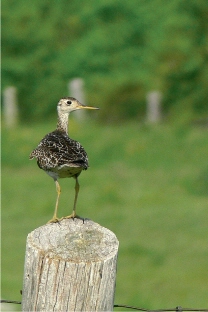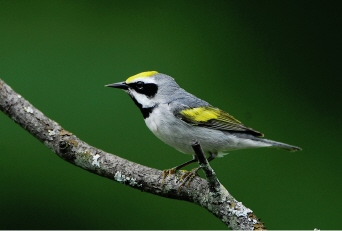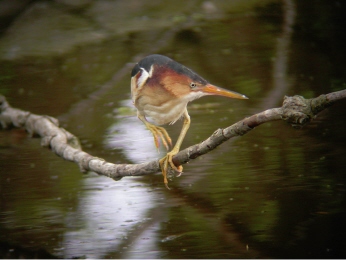The Reluctant Twitcher (10 page)

The Lord giveth â¦
â A
FTER
J
OB 1:21
B
ETWEEN MY RETURN FROM
P
ELEE
on May 16 and my departure for Rainy River on June 15, I see twenty more species without killing myself (a fact I come to regret later), bringing my total to 255.
Brant
(May 23). Jim Fairchild phones and swears there is a Brant floating in the third pond at Nonquon Sewage Lagoons; I am not fussy and go there, alone. My wife says she is busy despite happy memories of our first date. There are people who hold that there is something humorous about sewage lagoons, something to snigger about. Let it be said here and now, I do not number among them. I love a good sewage pond.
All is as Jim said. I feel sorry for the Brant. But it's a tick. I also get my first
Semipalmated Sandpiper
of the year.
Sedge Wren
(May 19). Presqu'ile. Margaret hears a tiny chip in the bushes by the beach. I must have been distracted. I didn't hear zip.
“Isn't that a Sedge Wren call note?” she asks modestly.
“Yeah, I think so,” I reply. I mean, what are you going to say: “I didn't hear nothin'?” It is, of course, a Sedge Wren, though I believe it has a strangulated syrinx or a hernia and has to call abnormally quietly. I don't feel so bad when Fred Helleiner practically steps on it later. He says, “I didn't realize it was so close.”
“What?” I say. “Didn't you hear it chip?”
Whimbrel
(May 24). Colonel Sam Smith Park. After failing spectacularly all along the eastern lakefront, I see repeated flocks, plus
Willow Flycatcher
and, finally,
Gray-cheeked
Thrush
, which was threatening to become a nemesis bird. I never saw one at Thickson's Woods or Pelee this year.
This is a good day, though not without its dangers. Hugh asked if it was okay if he brought his butterfly net. I unthinkingly said yes. While quietly looking at some interesting sparrow in deep grass, I feel a cold whoosh of air just as my hat is knocked off. Hughie practically decapitates me. “It was an interesting skipper,” he says insouciantly, adding sadly, “I missed him.”
“Well, you didn't miss me,” I say. He seems surprised and mentions something about my not being in the way next time. This experience stands me in good stead the rest of the year whenever I see the ol' net come out. I have fond memories of the
Reisefuehrer
tripping through long-grass meadows in his Bermuda shorts, baseball cap, and ever-present sneakers, pursuing butterflies or dragonflies and looking for all the world like a slightly more manic Nabokov.
Loggerhead Shrike
(May 25). Carden Alvar, Wylie Road, out behind bluebird box 10; where else?
Upland Sandpiper
(May 25). Wylie Road, teetering on a fence post like a snipe; plus
Vesper Sparrow
, plus
Common Night
hawk
at Alvar Road.
Clay-colored Sparrow
(May 26). Cameron Ranch. Turns out I can hear these suckers from seven metres away. Piece of cake. Nothing like the ol' Grasshopper Sparrow, which I practically have to be right on top of. Also
Merlin
in Kirkfield.
Yellow-throated Vireo
(May 29). Opinicon Road. Margaret hears it and I locate it in a far-off treetop. I claim to have heard it to save face.

Photo by
Andrew Don.
Upland Sandpiper.
Carden Alvar. On the
alvar, these birds compete
for the fence posts with the
Wilson's Snipe.
Golden-winged Warbler
(May 29). Opinicon Road. Margaret hears it as we drive by talking with the windows closed and the radio on.“Oh, wasn't that a Golden-winged?” asks Margaret unexpectedly. I don't tell her I couldn't hear a Golden-winged if it was perched on my ear and thrust its beak down my ear hole. We jump out and find a little group of them in nearby trees. My faith in Margaret, already considerable, grows. “Well, I'm sure you can at least hear that,” says Margaret as they sing away merrily. I claim to be revelling in the concert. I watch carefully. Each time one of them opens his gob, I say, “Oh, wow. Listen to that

Photo by
Sam Barone.
Golden-winged Warbler (male). Carden Alvar. Try showing one of these
to a non-birder in your scope!
little guy.” This technique works well with Brown Creeper also, I find. Just don't get out of sync.
Alder Flycatcher
(Number 250! May 29. It is at this stage that I start my countdown, numbering every bird.). We find the bird east of Cobourg in a special place Margaret knows. The bird drives me crazy with its calling before it finally zips out and sits on the wires for a minute before hiding again.
Ruddy Turnstone
(251, June 1). Cobourg Harbour, crawling all over the broken cement slab breakwater; not scenic, but it beats having them stealing fries from your dinner table in Tobago.
Northern Bobwhite
(June 4). Long Point area. I think I have a bird for my heard-only extras list. Bruce Falls counted this bird on his Baillie Birdathon and charged everybody for it. I figure if it was good enough for Dr. Falls, it is good enough for me. But I am wrong. I soon find out it is not good enough for the OBRC (Ontario Bird Records Committee). Apparently these birds are considered releases or escapees. Damn. And Bruce won't give me my money back! He tries to claim his wasn't an escapee. This doesn't work when I try to use it on Margaret. The OBRC owes me one.
Cattle Egret
(252, June 4). Seen from the car, head deep in cow dung near the poetically named town of Gasline.
Lark Sparrow
(253, June 4). Long Point area. Margaret and I nearly miss this bird until Hugh staggers across a lumpy field and flushes it out to the edge. We know from his body language he has either been attacked by killer bees or has seen the bird. We rush to the area toward which he is charging and get the bird in an open tree. I like them. Got a decent song on them, you know. No mealy-mouthing.
Louisiana Waterthrush
(254, June 4). Long Point area. This bird calls all around us for half an hour, repeatedly flying unseen from the forest floor to the canopy. Margaret sees it. Hugh sees it. Somehow I don't. We resort to tapes. The bird begins to tear around and I get repeated glimpses of it. I keep playing the tape though I know I shouldn't. I remember my vows, but I can do no other. Finally, I get my diagnostic view of it in a treetop. I ask it what the hell it is doing in a treetop, but it just gawks. This is my one overuse of tapes all year. I feel bad, but not quite as bad as if I had missed the bird. I do not want to have to look for the already much harassed Ganaraska Forest bird closer to home.
Least Bittern
(255, June 13). Lone Pine Marsh. After numerous attempts, in clouds of mosquitoes and up to my thighs in duck weed, I get a close up fly-by of a breeding pair, the female followed seconds later by the male, after which the flies seem a good deal less troublesome.

Photo
by Mike Burrell.
Least Bittern. Hillman's Marsh. This cooperative bird forgot how
notoriously hard to find it is supposed to be.
A number of these birds (Yellow-throated Vireo, Golden-winged Warbler, Louisiana Waterthrush, Least Bittern) were birds I hoped to get at Pelee and then had to make time to chase and find elsewhere later, when I could have been after other birds. See everything you can at Pelee or pay the price later.

And the Lord taketh away.
â
AFTER
J
OB 1:21
H
UGH HAS SEVERAL YOUNG HOTSHOTS
with keen ears lined up to accompany us to Rainy River but they drop away one by one, thereby missing the opportunity of a lifetime to bird with Hugh and me. Hugh is determined not to be stuck with me alone, a great confidence builder, and begins to ask around. Bob Carswell jumps at the opportunity, figuring he'll get a few laughs if nothing else. He will get more than he bargained for. He's got better ears than we do and he drinks, so I figure we haven't done too badly.
Friday June 15 finds us heading north in a stately PT Cruiser, which Hugh has managed to rent on an unlimited mileage basis. When the woman asked our destination, just as I was about to say Rainy River, Hugh said, “Oh, we're heading up Sudbury way and maybe a bit west of there.” I was not there when he returned it with five thousand kilometres on it. They can't have been too angry, however, because they gave him free baseball tickets, which thrilled him.
As we cruise north, we are in high spirits. I should be able to make up for any losses at Pelee. I hope to get twenty new species, which would put me at 275 in late June, a pretty good gaming position with over six months to get the remaining twenty-five birds and then some. Coady would be getting nervous if only he knew.
We talk of possible birds. Connecticut Warbler, which I did not bother to chase even when I was at Colonel Sam's when one was being seen â it was only a female, for heaven's sake â is a sure thing. In the bag, so to speak. Jean Iron assured me they would be dripping off the trees at eye level at close range. I consider adding it to my list even before leaving, but decide it will be more fun to wait until I actually see my first one for the trip. And, of course, Yellow Rail is another no-miss bird at Rainy River. Glenn Coady says there were kazillions of them last time he was at Rainy River and all the books list them in numerous places. But why waste time; just go to Fred's Marsh, knock the bird off, and get on with things.
We talk of other slightly less certain birds: Western Kingbird, Sprague's Pipit, Western Tanager, Western Grebe, Mountain Bluebird, and even Western Wood-Pewee. All seem likely at Barrie, possible at Sudbury, and highly unlikely at Sault Ste. Marie. Somehow they become progressively less likely as we near our destination. Why does this invariably happen? “Probably won't get any of them,” says Hugh morosely; not half as morosely, of course, as on our way home when we have indeed failed to see any of the aforementioned.
